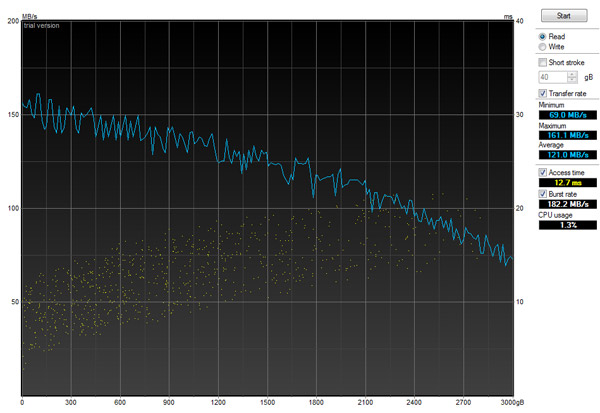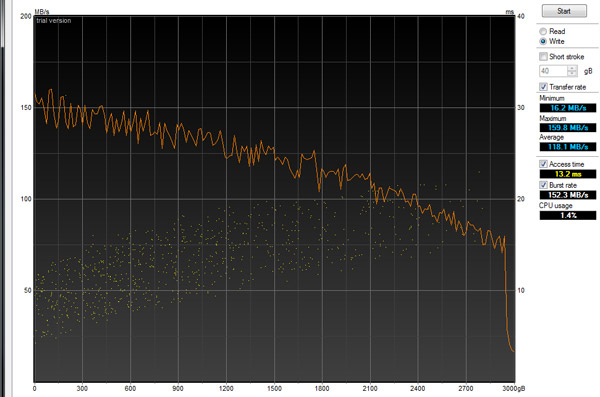The World's First 3TB HDD: Seagate GoFlex Desk 3TB Review
by Anand Lal Shimpi on August 23, 2010 12:39 AM EST- Posted in
- Storage
- Seagate
- HDDs
- GoFlex Desk
Performance vs. Capacity
I typically turn to HDTach for my performance vs. capacity graphs. Normally they are used to show SSD performance degradation without TRIM but in this case I genuinely wanted to see what the performance falloff was as you filled the drive up. HDTach had issues with the > 2TB of addresses on this drive so I used HD Tune instead.
Hard drives store data in circular patterns. Reading/writing to the outermost LBAs is faster (that’s just how circles work, you can cover more area in a single rotation on the outer track vs. the inner track). As a result, HDDs write data at the outmost part of the platters first and as the drive fills performance drops.
Sequential Read Performance vs. LBA

Sequential Write Performance vs. LBA

Peak performance, we’ve already discussed is at around 150MB/s over USB 3.0. Sequential performance at the highest LBAs drops to around 75MB/s. There’s one anomaly that I saw in my tests which you can see in the graph above. Performance drops down to 16.2MB/s for sequential writes in the last 100GB of the drive. This could be a problem with my particular drive or an issue related to the early nature of these 3TB drives.










81 Comments
View All Comments
mxnerd - Monday, August 23, 2010 - link
10 years ago Seagate is all about quality. Not any more. Every retail drives ( more than 5) I bought from Seagate in the past five years gone bad before the 5-year warranty.The problem with Seagate drives? They are too hot.
WD only gives you 3-year warranty for their drives, but I'm buying them exclusively now.
mewgirl - Monday, January 31, 2011 - link
WHY WOULD ANYONE WHO AS ANY BRAND KNOWLEDGE EVER BUY A WD EXTERNAL DRIVE??!?Sottilde - Monday, August 23, 2010 - link
Hard to believe the engineers could be thick enough to put a mesh grille on the side for looks only, without providing any actual ventilation. A major oversight IMO, especially if you tend to pound on your hardware.Indigo64 - Monday, August 23, 2010 - link
I realize this site and its standing on the web, but Google's test results show that hard drive temp isn't a factor for failure rates - at least not in the same manner in which people get all uptight about it.I have a laptop at home where the hard drive runs constantly around 50*C and it hasn't ever failed on me. I have a desktop system that has drives that run below 40*C and it's gone through three already.
"One of our key findings has been the lack of a consistent
pattern of higher failure rates for higher temperature
drives or for those drives at higher utilization levels.
Such correlations have been repeatedly highlighted
by previous studies, but we are unable to confirm them
by observing our population. Although our data do not
allow us to conclude that there is no such correlation,
it provides strong evidence to suggest that other effects
may be more prominent in affecting disk drive reliability
in the context of a professionally managed data center
deployment."
Interpret how you will, but if Seagate says this drive is fine without any active cooling, then why do people need to ding the drive for this "oversight"? It's all perceived performance stats in the PC realm - if it's hot, cool it down. If it's cool, don't bother it.
GeorgeH - Monday, August 23, 2010 - link
I don't have it in front of me, but IIRC the temperature range of that Google study was something like 10-50C, and they found that the sweet spot was 30-40C. 60C+ (as in this Seagate drive) isn't a "perceived" problem, it's a measurable one; re-read the paragraph where Anand found transfer rates dropping by 60%+ as the drive went into that range.wiak - Monday, August 23, 2010 - link
ooh the irony ;)conwayboys - Monday, August 23, 2010 - link
Never ceases to amaze me why computer and drive manufacturers do not design cases with natural convection, struck me the other day at work when the IT boffins had a major crash due to a faulty fan in the server room. WTF there were three of them standing around designing a new air conditioning system for the server room. I got the step ladder and removed 4 panels from the false ceiling to allow the heat to escape into the roofspace, instant temperature drop, so why cant we employ the same thinking to computer cases and drive cases vent the top and the bottom ensuring hot air rising will pull cold air in from the bottom, obviously spillage issues with moisture getting in the vents, so the vents can be on the sides near the top with the fins slanted downwards still allowing hot air to escape.compuser2010 - Monday, August 23, 2010 - link
32-bit Windows 7 also supports GPT. However, only for *data* disks/arrays; even if the capacity is less than 2 TB. Formatting using GPT can be done in "Computer Management."2 TB may seem like a huge amount of memory to some. But it is an increasingly paltry amount of memory for those who edit video (especially uncompressed) and who work with Blu-ray Discs (copying a disc to another disc, copying discs to a computer, authoring discs, leaving those disc projects on the computer for a while, etc.).
Randomblame - Monday, August 23, 2010 - link
oh wait that was ram... still. I could use 3tb right now but 5 platters - that's too many. I'll be waiting. My current setup is 3 500gb seagate baracuda 7200.12s in raid 0 backed up by a 2tb cuda. That way I've got only 3 platters spinning for low noise, reliability, and high data density. Though this thing uses 600gb platters which is nice I think I'll wait a bit maybe we'll get some higher data density per platter while we're waiting for microsoft and motherboard vendors to get this 2tb cap fixed.futbol4me - Tuesday, August 24, 2010 - link
anyone know? i have an external 2.5" drive hanging off my apple extreme router that spins 24/7 but was wondering if newer external drives have some power savings features.